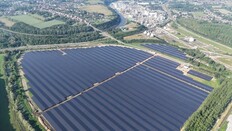- The solar farm has an installed capacity of 60MW and reduces CO2 emissions by 14,000 tonnes annually.
- The project features over 90,000 solar panels, covering an area equivalent to 56 football pitches.
- INEOS Inovyn aims to cut CO2 emissions by over 33% by 2030 and achieve Net Zero by 2050.
- The solar farm uses latest-generation Heterojunction panels and an underground power line connection.

Project Overview
INEOS Inovyn, in collaboration with PerPetum Energy and Green4Power, has launched a new photovoltaic solar farm in Belgium. The facility boasts an installed capacity of 60MW, dedicated to the Jemeppe production site, and is expected to reduce annual CO2 emissions by 14,000 tonnes. The solar farm spans an area equivalent to 56 football pitches, featuring over 90,000 solar panels.
Technological Features
The solar farm incorporates advanced technology, including latest-generation Heterojunction panels that offer higher efficiency. It also features an underground power line connection to the Jemeppe plant and central inverters, which enhance reliability, cost-effectiveness, and durability.
Strategic Goals
This initiative is part of INEOS Inovyn's broader decarbonization strategy, aiming to reduce CO2 emissions across all sites by more than 33% by 2030 and achieve Net Zero by 2050. The solar farm supports the production of low carbon products, contributing to Europe's green transition.
Industry Context
The European plastics industry faces challenges such as higher energy costs, limited access to raw materials, and a complex regulatory environment, which create a competitiveness gap with the US and China. Projects like this solar farm are crucial for maintaining the competitiveness of the European industry and reducing dependency on imports.

